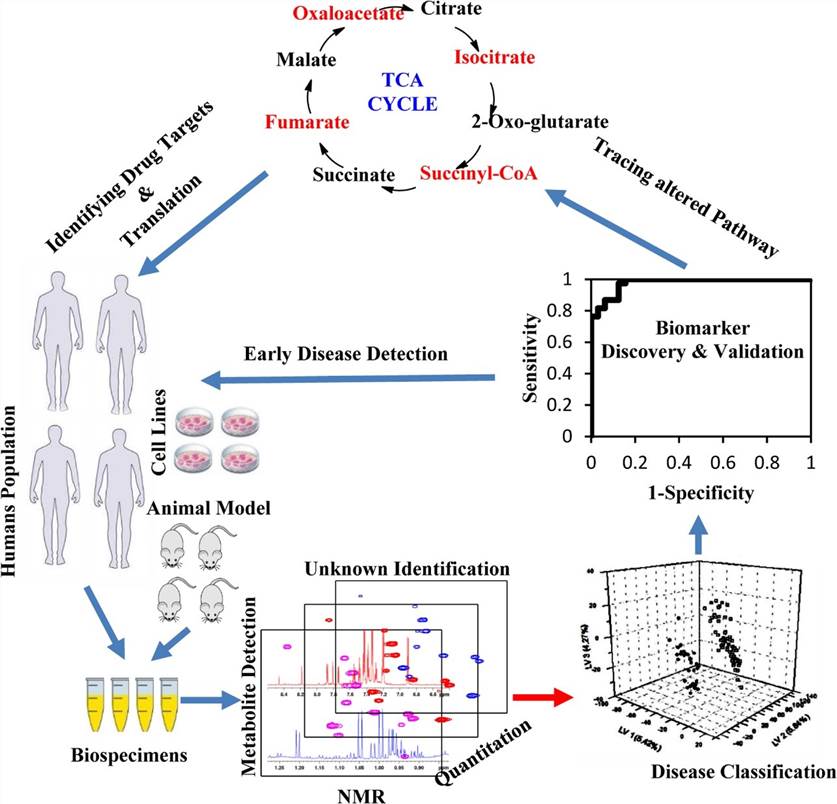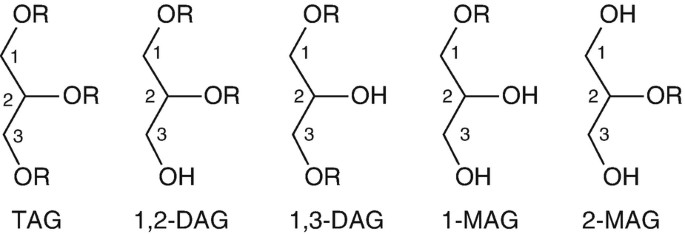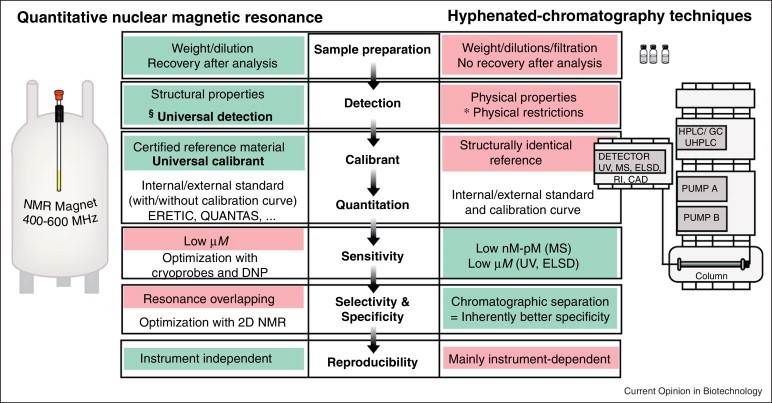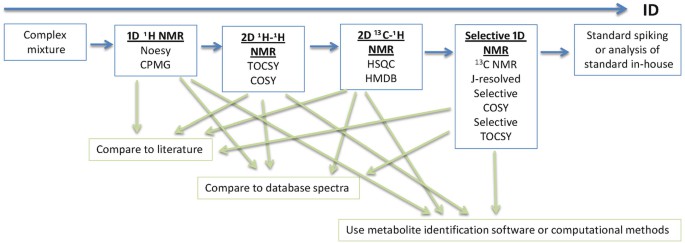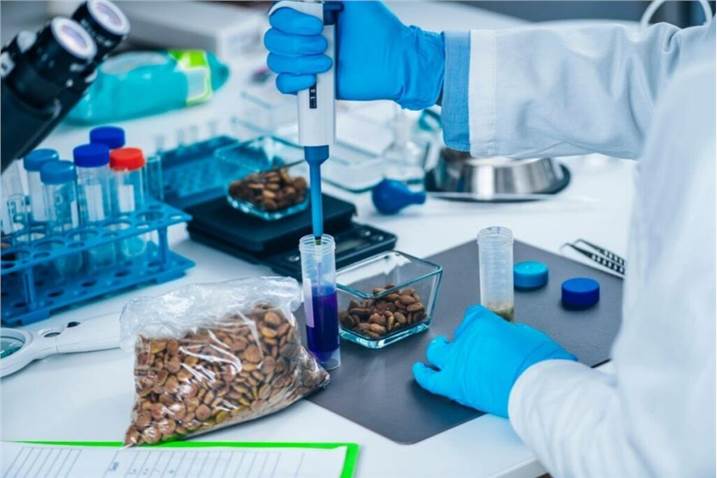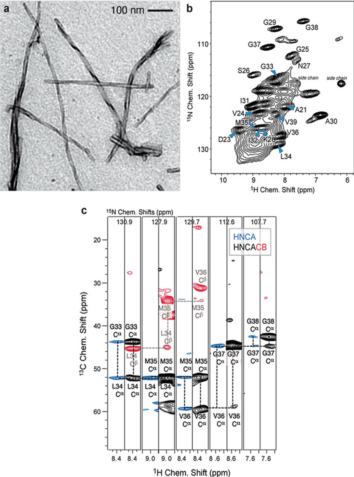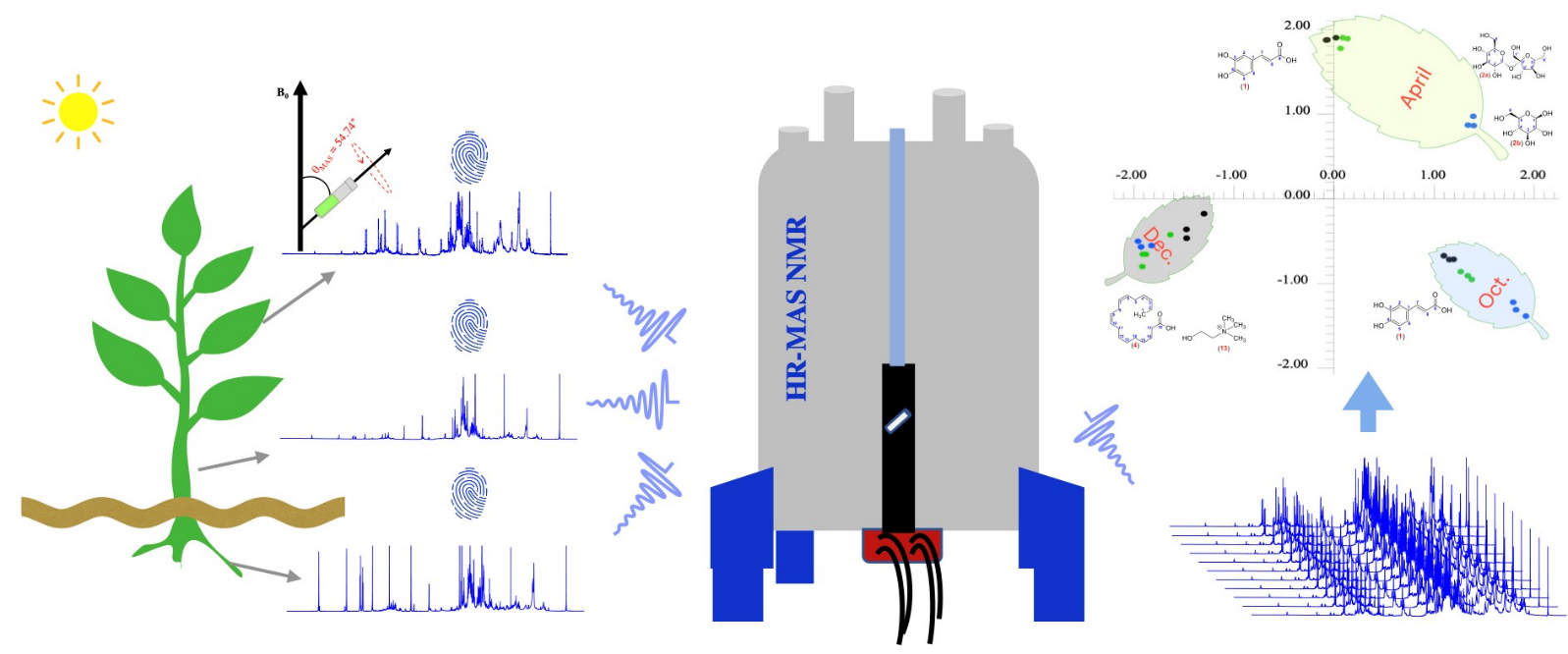Food analysis is critical for ensuring safety, quality, authenticity, and nutritional value. Nuclear Magnetic Resonance (NMR) spectroscopy has emerged as a versatile, non-destructive analytical tool in this field, offering unparalleled insights into the molecular composition and dynamic processes of food matrices. Unlike traditional methods such as chromatography or mass spectrometry (MS), NMR provides a holistic view of food systems without extensive sample preparation.
At Creative Biostructure, we offer NMR solutions for food analysis. We focus on 1H and 13C NMR to provide customers with qualitative and quantitative analysis of food, as well as quality and safety analysis services.
 Figure 1. Review scheme of nuclear magnetic resonance for food quality evaluation. (Tian et al., 2019)
Figure 1. Review scheme of nuclear magnetic resonance for food quality evaluation. (Tian et al., 2019)
Principles of NMR Spectroscopy Tailored for Food Matrices
NMR spectroscopy detects the magnetic properties of atomic nuclei (e.g., 1H, 13C, 31P) in a strong magnetic field. Key principles include:
- Chemical Shift: Reflects the electronic environment of nuclei, enabling identification of functional groups (e.g., fatty acids, sugars).
- Spin-Spin Coupling: Splitting of peaks due to neighboring nuclei provides structural details (e.g., monosaccharide linkages).
- Relaxation Times (T1/T2): Inform on molecular mobility and interactions in complex matrices (e.g., water in gels or emulsions).
- Multidimensional NMR: Techniques like COSY, HSQC, and NOESY resolve overlapping signals in intricate food spectra.
For food analysis, high-resolution magic-angle spinning (HR-MAS) NMR is often used for semi-solid samples (e.g., fruits, cheese), while solution-state NMR analyzes liquids (e.g., juices, oils).
Advantages of NMR in Food Analysis
NMR outperforms conventional methods in several ways:
- Minimal Sample Preparation: No derivatization or separation required.
- Non-Destructive: Preserves samples for further testing.
- Quantitative: Directly measures concentrations without calibration curves.
- Comprehensive Profiling: Captures hundreds of metabolites in a single experiment.
- Structural Elucidation: Identifies unknown compounds (e.g., adulterants or toxins).
Key Applications in Food Science
Compositional Analysis
- Lipids: Proton NMR (1H NMR) plays a central role in lipidomics, enabling precise quantification of saturated and unsaturated fatty acids in various food oils. Additionally, it allows for the detection of lipid oxidation products, such as aldehydes and hydroperoxides, which are indicative of rancidity and overall oil degradation—a crucial factor in evaluating shelf life and nutritional quality.
- Carbohydrates: Carbon-13 NMR (13C NMR) is highly effective in distinguishing structurally similar sugars, such as glucose, fructose, and sucrose. This application is particularly relevant in the authentication and compositional analysis of natural sweeteners in products like honey and fruit juices, where subtle differences in sugar profiles can have implications for both nutritional labeling and regulatory compliance.
- Proteins: The use of multidimensional NMR techniques, such as 1H-15N correlation spectroscopy, enables the investigation of protein conformational changes. In particular, this method can assess protein denaturation or aggregation, especially in thermally processed dairy products like milk, where structural integrity impacts both nutritional value and allergenic potential.
- Vitamins: NMR facilitates the identification and quantification of water-soluble vitamins, especially B-complex vitamins, in fortified food products. These micronutrients are typically present in low concentrations but are critical for assessing the efficacy of food fortification strategies.
- Polyphenols: Detailed structural elucidation of polyphenolic compounds, including flavonoids and tannins, is achievable through NMR spectroscopy. This application is particularly prominent in the study of antioxidant-rich foods and beverages, such as wine and tea, where polyphenol profiles contribute to both health benefits and sensory characteristics.
 Figure 2. Applications of nuclear magnetic resonance spectroscopy to the evaluation of complex food constituents. (Cao et al., 2020)
Figure 2. Applications of nuclear magnetic resonance spectroscopy to the evaluation of complex food constituents. (Cao et al., 2020)
Select Service
- Qualitative NMR Analysis of Ingredients in Food
- Compositional and Quantitative Analysis of Oils and Lipids
- NMR-based Dairy Product Analysis
- NMR-based Honey Analysis
- NMR-based Juice Analysis
- NMR-based Meat Analysis
- NMR-based Fruits and Vegetables Analysis
- Quantitative NMR Analysis of Foods
- Qualitative NMR Analysis of Edible Oil and Fat Ingredients in Food
- Qualitative NMR Analysis of Starch in Foods
- Qualitative Analysis Food Polysaccharides by NMR
- Qualitative Analysis of Food Moisture by NMR
Authenticity and Adulteration Detection
- Geographical Origin: NMR-based metabolomics has demonstrated exceptional utility in determining the geographical origin of food products. For example, olive oils from different regions (e.g., Italy vs. Spain) can be distinguished based on their unique terpene and phenolic fingerprints. Similarly, the provenance of coffee beans can be traced through the analysis of specific metabolites such as chlorogenic acids, offering a robust tool against mislabeling and fraudulent claims.
- Adulterant Identification
- Melamine in Milk: Proton NMR provides a rapid and sensitive approach for detecting melamine, a nitrogen-rich compound illegally added to elevate apparent protein content. Characteristic signals from triazine rings can be observed even at parts-per-million (ppm) levels.
- Sudan Dye in Spices: The presence of illegal synthetic dyes such as Sudan I–IV in spices can be confirmed through 13C NMR by identifying distinct aromatic carbon signals, thereby ensuring food safety and regulatory compliance.
- Fruit Juice Adulteration: The addition of synthetic sugars or organic acids to natural juices can be detected via deviations in NMR spectral profiles, allowing for the identification of fraudulent practices with high specificity.
 Figure 3. Nuclear magnetic resonance as an analytical tool for monitoring the quality and authenticity of dairy foods. (Balthazar et al., 2020)
Figure 3. Nuclear magnetic resonance as an analytical tool for monitoring the quality and authenticity of dairy foods. (Balthazar et al., 2020)
Safety and Contaminant Screening
- Mycotoxins: Detection of hazardous mycotoxins, such as aflatoxins in cereals and nuts, is possible using NMR methods in conjunction with fluorine-labeled antibodies (19F NMR), providing a selective and sensitive screening technique for these potent toxins.
- Pesticide Residues: 31P NMR is particularly suited for the quantification of organophosphate pesticide residues in fruits and vegetables, offering a direct and non-invasive analytical approach.
- Allergens: The detection of trace levels of allergenic proteins, such as gluten in gluten-free labeled products, can be accomplished using peptide fingerprinting techniques via NMR. This has significant implications for consumer health, particularly among individuals with celiac disease or gluten sensitivity.
Select Service
Food Processing and Quality Control
- Fermentation Monitoring: NMR enables real-time monitoring of fermentation processes by tracking the production of key metabolites such as ethanol, lactic acid, and various amino acids. This capability is invaluable in the manufacture of fermented foods and beverages, including beer, yogurt, and kombucha, where precise control over metabolic pathways determines product quality.
- Thermal Treatment Assessment: Heat-induced reactions, such as the Maillard reaction, produce a range of compounds including acrylamide—a potential carcinogen found in baked goods. NMR can identify and quantify these reaction products, offering insights into thermal processing outcomes and safety implications.
- Shelf-Life Prediction: Time-resolved NMR techniques are employed to study the kinetics of lipid oxidation in edible oils, enabling predictive modeling of product shelf life. This helps manufacturers optimize storage conditions and packaging materials to maintain food quality over time.
 Figure 4. Conceptual diagram of the proposed proton nuclear magnetic resonance (1H-NMR) spectral analysis using parameter visualization of benchtop NMR spectra toward food process monitoring. NMR is widely used in food process monitoring in primary industries such as fishery, dairy farming, and agriculture. For example, food processes of the boiling status of carrot (a), the fermentation status of milk (b), and the quality of fish meats (c) were handled. (d1) For food process monitoring, a parameter visualization of NMR data is depicted. (d2) Conceptual diagram of transition simulation to use high magnetic field NMR data are shown. (Hara et al., 2022)
Figure 4. Conceptual diagram of the proposed proton nuclear magnetic resonance (1H-NMR) spectral analysis using parameter visualization of benchtop NMR spectra toward food process monitoring. NMR is widely used in food process monitoring in primary industries such as fishery, dairy farming, and agriculture. For example, food processes of the boiling status of carrot (a), the fermentation status of milk (b), and the quality of fish meats (c) were handled. (d1) For food process monitoring, a parameter visualization of NMR data is depicted. (d2) Conceptual diagram of transition simulation to use high magnetic field NMR data are shown. (Hara et al., 2022)
Select Service
Nutritional and Metabolic Studies
- Nutraceutical Profiling: The composition and concentration of health-promoting compounds, such as omega-3 fatty acids, can be quantified in functional foods derived from algae, flaxseed, or fish oil. NMR offers high accuracy and reproducibility for profiling these essential lipids.
- Gut Microbiome Interactions: Metabolite changes in fermented foods—such as kimchi, sauerkraut, and kefir—can be tracked using NMR-based metabolomics to explore their impact on gut microbial ecology and host health. This application is pivotal in advancing our understanding of food–microbiome interactions and their role in human nutrition.
Related Reading
Advanced NMR Techniques in Food Science
High-Resolution Magic Angle Spinning (HR-MAS) NMR
High-Resolution Magic Angle Spinning (HR-MAS) NMR spectroscopy allows for the direct analysis of semi-solid or intact biological samples without the need for extensive sample preparation, such as homogenization or solvent extraction. This technique is particularly advantageous for studying native water and lipid distribution in complex tissues like meat, fish, and dairy products. HR-MAS facilitates the non-destructive examination of lipid oxidation processes, water mobility, and protein degradation in situ, preserving the structural integrity of the sample. Its application is vital for understanding quality deterioration during storage and processing, as well as for authenticating food products based on their microstructural chemical signatures.
Hyphenated NMR Techniques
Hyphenated techniques, such as Liquid Chromatography–NMR (LC-NMR) and LC-NMR–Mass Spectrometry (LC-NMR/MS), combine the separation power of chromatography with the structural elucidation capacity of NMR and the mass accuracy of MS. This integrated approach is particularly effective in resolving and identifying complex mixtures of bioactive compounds, such as polyphenols, alkaloids, and glycosides found in herbal extracts, functional foods, and dietary supplements. These platforms enable a comprehensive metabolic profiling by providing both qualitative and quantitative insights, thus supporting authentication, efficacy assessment, and safety evaluation of nutraceutical ingredients. Additionally, LC-NMR/MS is invaluable in untargeted metabolomics for food origin verification and fraud detection.
Portable and Low-Field NMR Systems
Portable and benchtop NMR instruments, typically operating at low magnetic fields (e.g., 40–80 MHz), have emerged as cost-effective and user-friendly tools for rapid, in-field food analysis. These compact systems are suitable for routine testing of key physicochemical properties, such as moisture content in cereal grains, oil concentration in oilseeds (e.g., soybeans, sunflower), and fat content in dairy or meat products. While low-field NMR systems offer lower spectral resolution compared to their high-field counterparts, their simplicity, speed, and non-invasive operation make them ideal for quality control, supply chain monitoring, and on-site screening in agricultural or industrial settings.
Hyperpolarization Techniques
Hyperpolarization methods, such as Dissolution Dynamic Nuclear Polarization (d-DNP), have dramatically improved the inherent sensitivity of NMR spectroscopy—enhancing signal intensities by several orders of magnitude. This breakthrough enables the detection and quantification of low-abundance metabolites and trace components that would otherwise fall below conventional detection limits. In food science, d-DNP is increasingly utilized for the analysis of labile micronutrients (e.g., water-soluble vitamins in fruit juices), antioxidant metabolites, and degradation products during food processing or storage. The technique also shows promise in kinetic studies, allowing real-time observation of fast biochemical transformations in food systems.
Case Studies
Case 1: Analysis of extra virgin olive oils from two Italian regions by means of proton nuclear magnetic resonance relaxation and relaxometry measurements
Recent research highlights the potential of non-destructive NMR relaxation techniques for characterizing and authenticating extra virgin olive oils (EVOOs). This study focused on measuring proton relaxation times (T1 and T2) at multiple magnetic field strengths (2, 100, and 400 MHz) using 1H NMR relaxometry, applied directly to EVOO samples without any chemical or physical modification. EVOOs from Tuscany and Apulia (Italy) exhibited consistent relaxation behavior, suggesting that T1 and T2 values are intrinsic features of EVOOs, largely independent of geographic origin or cultivar. This supports their potential use in quality control. Additionally, while low-field spectra (e.g., at 2 MHz) lack resolution due to magnet limitations, the relaxation data still provide meaningful insight into the oils' molecular characteristics.
 Figure 5. 1H NMR spectra of a representative EVOO sample (at_28) recorded at 2 MHz permanent magnet and at 100 and 400 MHz superconducting magnets at room temperature. (Gradišek et al., 2021)
Figure 5. 1H NMR spectra of a representative EVOO sample (at_28) recorded at 2 MHz permanent magnet and at 100 and 400 MHz superconducting magnets at room temperature. (Gradišek et al., 2021)
Case 2: Compositional identification and authentication of Chinese honeys by 1H NMR combined with multivariate analysis
Due to the increasing prevalence of honey adulteration in China—driven by its high market value and export demand—authenticity verification has become critical for producers, consumers, and regulators. This study employed high-resolution 1H NMR spectroscopy to analyze 90 authentic and 75 adulterated Chinese honey samples, successfully identifying and quantifying 65 major and minor compounds. Using multivariate statistical techniques—including PCA, LDA, and OPLS-DA—researchers developed robust classification models that distinguished adulterated from authentic honey with 97.6% accuracy. Key marker compounds such as proline, xylobiose, β-glucose, turanose, and lysine were identified as discriminants through a volcano plot analysis, providing a chemical fingerprinting approach to support market surveillance and fraud prevention.
 Figure 6. Graphic abstract of honey fraud detection using NMR. (He et al., 2020)
Figure 6. Graphic abstract of honey fraud detection using NMR. (He et al., 2020)
Challenges and Limitations
- Sensitivity: NMR has lower sensitivity than mass spectrometry, often requiring analyte concentrations in the μM–mM range. This limits detection of trace-level compounds without signal enhancement techniques.
- Cost: High-field NMR systems (>400 MHz) are expensive to acquire and maintain, with added costs for cryogens, infrastructure, and skilled personnel.
- Data Complexity: NMR metabolomics involves complex spectra that demand advanced multivariate tools (e.g., PCA, PLS-DA) and statistical expertise, posing a barrier for non-specialists.
- Matrix Effects: Signal overlap is common in complex food matrices (e.g., coffee, chocolate), complicating metabolite identification without high-field or multidimensional NMR approaches.
Future Directions
- AI-Enhanced Analysis: Machine learning tools are improving automated peak assignment, compound identification, and fraud detection, streamlining NMR workflows.
- In-Situ Monitoring: Miniaturized NMR probes enable real-time analysis in food processes like fermentation, supporting process control and quality assurance.
- Green Solvent Alternatives: Deep eutectic solvents (DESs) offer eco-friendly alternatives to deuterated solvents, enhancing sustainability in NMR sample preparation.
- Global NMR Databases: Initiatives like FoodBabel aim to standardize NMR food profiles, promoting data sharing, reproducibility, and global food authentication.
In summary, NMR spectroscopy is a cornerstone of modern food analysis, bridging the gap between molecular-level insights and industrial applications. Its ability to provide rapid, non-destructive, and comprehensive data makes it indispensable for ensuring food safety, authenticity, and quality. As advancements in automation, sensitivity, and computational tools progress, NMR will continue to revolutionize the food industry, addressing emerging challenges from farm to fork.
 Figure 7. Infografic of the information that can be obtained along the food production/consumption chain by NMR, through a foodomic approach. (Trimigno et al., 2015)
Figure 7. Infografic of the information that can be obtained along the food production/consumption chain by NMR, through a foodomic approach. (Trimigno et al., 2015)
From composition to nutritional profiling, NMR offers a powerful, non-destructive tool for comprehensive food analysis. Ensure your products meet the highest standards. Contact us to explore how our NMR services can support your food quality goals.
References
- Balthazar CF, Guimarães JT, Rocha RS, et al. Nuclear magnetic resonance as an analytical tool for monitoring the quality and authenticity of dairy foods. Trends in Food Science & Technology. 2021;108:84-91. https://doi.org/10.1016/j.tifs.2020.12.011
- Cao R, Liu X, Liu Y, et al. Applications of nuclear magnetic resonance spectroscopy to the evaluation of complex food constituents. Food Chemistry. 2021;342:128258. https://doi.org/10.1016/j.foodchem.2020.128258
- Gallo V, Mastrorilli P, Cafagna I, et al. Effects of agronomical practices on chemical composition of table grapes evaluated by NMR spectroscopy. Journal of Food Composition and Analysis. 2014;35(1):44-52. https://doi.org/10.1016/j.jfca.2014.04.004
- Gradišek A, Cifelli M, Ancora D, et al. Analysis of extra virgin olive oils from two Italian regions by means of proton nuclear magnetic resonance relaxation and relaxometry measurements. J Agric Food Chem. 2021;69(41):12073-12080. https://doi.org/10.1021/acs.jafc.1c00622
- Hara K, Yamada S, Chikayama E, Kikuchi J. Parameter visualization of benchtop nuclear magnetic resonance spectra toward food process monitoring. Processes. 2022;10(7):1264. https://doi.org/10.3390/pr10071264
- He C, Liu Y, Liu H, Zheng X, Shen G, Feng J. Compositional identification and authentication of Chinese honeys by 1H NMR combined with multivariate analysis. Food Research International. 2020;130:108936. https://doi.org/10.1016/j.foodres.2019.108936
- Kharbach M, Alaoui Mansouri M, Taabouz M, Yu H. Current application of advancing spectroscopy techniques in food analysis: data handling with chemometric approaches. Foods. 2023;12(14):2753. https://doi.org/10.3390/foods12142753
- Tang F, Vasas M, Hatzakis E, Spyros A. Magnetic resonance applications in food analysis. In: Annual Reports on NMR Spectroscopy. Vol 98. Elsevier; 2019:239-306. https://doi.org/10.1016/bs.arnmr.2019.04.005
- Tian Y, He Q, Chen X, Wang S. Nuclear magnetic resonance spectroscopy for food quality evaluation. In: Evaluation Technologies for Food Quality. Elsevier; 2019:193-217. https://doi.org/10.1016/B978-0-12-814217-2.00011-1
- Trimigno A, Marincola FC, Dellarosa N, Picone G, Laghi L. Definition of food quality by NMR-based foodomics. Current Opinion in Food Science. 2015;4:99-104. https://doi.org/10.1016/j.cofs.2015.06.008
